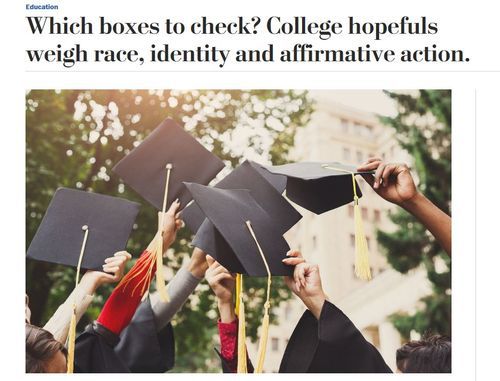
12/24/2018
From the Washington Post:
Which boxes to check? College hopefuls weigh race, identity and affirmative action.
By Nick Anderson December 23 at 4:41 PM
Sabria Kazmi’s background defies easy classification. She has grandparents from Tennessee, Iraq and two countries in South Asia.
So when the 18-year-old filled out her college application, she puzzled over what boxes to check. The task is all the more sensitive this year amid the mounting debate over the role of race and ethnicity in admissions.
First, Kazmi came to white. Check. Then Asian. Check. Followed by Middle Eastern and Pakistani. Check, check. She found a blank space to write in her Bangladeshi roots.
Kazmi, a high school senior in Northern Virginia, could have gone further because one grandmother is part Cherokee. But she stopped there.
She’s not Elizabeth Warren-level greedy about getting affirmative action bennies.
The roiling national debate over affirmative action in college admissions has raised the stakes for these questions about identity. Hundreds of thousands of applicants are wrestling with whether and how to describe their race and ethnicity and what that information should mean to the gatekeepers reading their files.
… Officials at Thomas Jefferson High School for Science and Technology in Fairfax County, Va., helped The Post convene them for a 90-minute focus group on race and admissions. The seniors, all aiming for selective colleges, held strong and sometimes clashing views.
Wenxi Huang, 17, confessed to an “itching, nagging feeling” when he checked the box on his application indicating Asian ancestry. The Chinese American student felt the information should be irrelevant in admission decisions. “I just want to live in a country where my race doesn’t matter,” he said. “Where I’m never judged or picked or excluded for my race.”
Jennifer Hernández, also 17, a Salvadoran American, wants colleges to take race and ethnicity into account. Her Hispanic identity “is something that makes me who I am,” she said. “It adds to my character and adds to my personality.”
… TJ screens applicants for its ninth-grade class through test scores, grades, essays and teacher recommendations. About 70 percent of its students are of Asian ancestry, and about 21 percent are white, according to county data. Fewer than 5 percent are black or Hispanic — a statistic that fuels perennial debate in Northern Virginia about access and equity. (Another 5 percent identify as multiracial.)
TJ’s admissions team does not consider race. But many selective colleges do — and they want as much detail as they can get.
… For example, users who identified as Hispanic or Latino could then click one or more boxes from a menu of Cuba, Mexico, Puerto Rico, Spain, Central America or South America. Or they could fill in a blank to give another answer.
Don’t check Cuban, I hear.
Ethan Phillips, 17, a TJ senior, said he paused briefly on the race question and consulted with his parents. He had heard speculation that identifying as white could have “a negative effect on the rest of the application.”
Phillips considered whether he could, or should, note his family’s Irish immigrant heritage. “My parents and grandparents came from farmers and blue-collar workers in Missouri,” he said. “That’s part of my story.” But there didn’t seem to be an easy way to indicate all of that. He checked the “white” box and moved on.
Damn, the Irish became white.
Sebastián Ibarrarán, 17, the son of Mexican immigrants, said race and ethnicity remain crucial for understanding the background of applicants, regardless of family income. He noted that he lives in McLean, an affluent suburb, and comes from a family with experience in higher education. On paper, he said, he might look nearly the same as many of his white neighbors who are not Hispanic.
I’m guessing that young Mr. Ibarrarán, who is as white-looking as Alfonso Cuaron, might be related to economist Pablo Ibarrarán of the Inter-American Development Bank in DC. Clearly, a white economist’s white son (if my guess is correct) needs a hand-up to make up for all that white racism he has suffered.
“But the thing is, none of these people who lived around me, they never had to deal with, in fifth grade, one of their friends saying, ‘Oh, Mexicans are rapists and druggies,’ “ Ibarrarán said. Nor, he said, did those neighbors face assumptions about the educational credentials of Hispanic students.
Ibarrarán said he often senses put-downs from people who believe he doesn’t have to try as hard as his peers to get into top colleges, that his SAT scores don’t have to be quite as high to make the cut. “Not only is that really hard,” he said, “but it’s also false because these colleges, they actually see a lot more than you think they see.”
Hernández said similar experiences shape her views. She grew emotional as she recalled the “differences in expectations” that she has faced while growing up as a Hispanic student accepted into a highly competitive public high school. She said she has endured taunts about the likelihood of her becoming a teen mom before becoming a scientist. (For the record, she is not a mother.) There are those, she said, “who think you got here because you didn’t earn it. Even though you did. You worked hard — maybe even twice as hard, maybe three times as hard, to get where you are. But it’s never acknowledged.”
Our culture constantly grooms young immigrant elites to play the racial resentment card at every opportunity.
Is that wise?
By the way, please don’t pester high school students on social media for dumb stuff they say in the Washington Post. They are kids and they are just feeding back what our society wants them to parrot.
This is a content archive of VDARE.com, which Letitia James forced off of the Internet using lawfare.